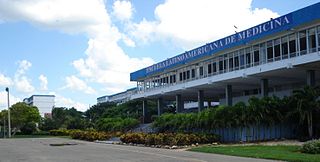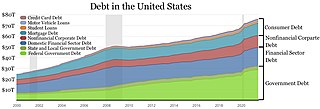
A scholarship is a form of financial aid awarded to students for further education. Generally, scholarships are awarded based on a set of criteria such as academic merit, diversity and inclusion, athletic skill, and financial need.

A student loan is a type of loan designed to help students pay for post-secondary education and the associated fees, such as tuition, books and supplies, and living expenses. It may differ from other types of loans in the fact that the interest rate may be substantially lower and the repayment schedule may be deferred while the student is still in school. It also differs in many countries in the strict laws regulating renegotiating and bankruptcy. This article highlights the differences of the student loan system in several major countries.
A medical school is a tertiary educational institution, professional school, or forms a part of such an institution, that teaches medicine, and awards a professional degree for physicians. Such medical degrees include the Bachelor of Medicine, Bachelor of Surgery, Master of Medicine, Doctor of Medicine (MD), or Doctor of Osteopathic Medicine (DO). Many medical schools offer additional degrees, such as a Doctor of Philosophy (PhD), master's degree (MSc) or other post-secondary education.

The Warren Alpert Medical School is the medical school of Brown University, located in Providence, Rhode Island. Originally established in 1811, it was the third medical school to be founded in New England after only Harvard and Dartmouth. However, the original program was suspended in 1827, and the four-year medical program was re-established almost 150 years later in 1972, granting the first MD degrees in 1975.

Residency or postgraduate training is a stage of graduate medical education. It refers to a qualified physician, veterinarian, dentist, podiatrist (DPM) or pharmacist (PharmD) who practices medicine, veterinary medicine, dentistry, podiatry, or clinical pharmacy, respectively, usually in a hospital or clinic, under the direct or indirect supervision of a senior medical clinician registered in that specialty such as an attending physician or consultant. In many jurisdictions, successful completion of such training is a requirement in order to obtain an unrestricted license to practice medicine, and in particular a license to practice a chosen specialty. In the meantime, they practice "on" the license of their supervising physician. An individual engaged in such training may be referred to as a resident, registrar or trainee depending on the jurisdiction. Residency training may be followed by fellowship or sub-specialty training.

Uniformed Services University of the Health Sciences (USU) is a health science university of the U.S. federal government. The primary mission of the school is to prepare graduates for service to the U.S. at home and abroad as uniformed health professionals, scientists and leaders; by conducting cutting-edge, military-relevant research; by leading the Military Health System in key functional and intellectual areas; and by providing operational support to units around the world.

Escuela Latinoamericana de Medicina, formerly Escuela Latinoamericana de Ciencias Médicas, is an international public medical school operated by the Cuban government established in 1999 and supported by the Venezuelan Government (RBDEV). Its mission is to "contribute to the training of Primary Health Care physicians in diverse regions of the World" according to Almaty objectives.
A medicalintern is a physician in training who has completed medical school and has a medical degree, but does not yet have a license to practice medicine unsupervised. Medical education generally ends with a period of practical training similar to internship, but the way the overall program of academic and practical medical training is structured differs depending upon the country, as does the terminology used.
A Federal Perkins Loan, or Perkins Loan, was a need-based student loan part of the Federal Direct Student Loan Program, offered by the U.S. Department of Education to assist American college students in funding their post-secondary education. The program was named after Carl D. Perkins, a former member of the U.S. House of Representatives from Kentucky.
The Medical Rural Bonded Scholarship (MRBS) Scheme is an Australian government program designed to address the shortage of doctors in rural areas. As part of the scheme doctors are required to work for 20 hours per week in an area classified as RA2-5 for 9 months of the year over 4-5.5 years, once they have attained Fellowship and commenced their return of service period. Where these doctors work for the rest of the time is up to them, the location they choose to work in is also up to them. although they are restricted to working in areas classified as RA2-5 for their return of service.

The Appalachian College of Pharmacy (ACP), formerly known as the University of Appalachia, College of Pharmacy, is a private doctoral pharmacy school located in Oakwood, Virginia. The school, established in 2003, is Virginia's only three-year accelerated Doctor of Pharmacy program. ACP's mission is to improve the health outcomes of rural and underserved communities, particularly those in Central Appalachia, through education, service, and scholarship.
Government sponsored Student Loans in Canada was designed to help post-secondary students pay for their education in Canada. The federal government funds the Canada Student Loan Program (CSLP) and the provinces may fund their own programs or be integrated with the CSLP. In addition, Canadian banks offer commercial loans targeted for students in professional programs.

In the United States, student loans are a form of financial aid intended to help students access higher education. In 2018, 70 percent of higher education graduates had used loans to cover some or all of their expenses. With notable exceptions, student loans must be repaid, in contrast to other forms of financial aid such as scholarships, which are not repaid, and grants, which rarely have to be repaid. Student loans may be discharged through bankruptcy, but this is difficult. Research shows that access to student loans increases credit-constrained students' degree completion, later-life earnings, and student loan repayment while having no impact on overall debt.
Medical school in the United States is a graduate program with the purpose of educating physicians in the undifferentiated field of medicine. Such schools provide a major part of the medical education in the United States. Most medical schools in the US confer upon graduates a Doctor of Medicine (MD) degree, while some confer a Doctor of Osteopathic Medicine (DO) degree. Most schools follow a similar pattern of education, with two years of classroom and laboratory based education, followed by two years of clinical rotations in a teaching hospital where students see patients in a variety of specialties. After completion, graduates must complete a residency before becoming licensed to practice medicine.
The Empowering Patients First Act is legislation sponsored by Rep. Tom Price, first introduced as H.R. 3400 in the 111th Congress. The bill was initially intended to be a Republican alternative to the America's Affordable Health Choices Act of 2009, but has since been positioned as a potential replacement to the Patient Protection and Affordable Care Act (PPACA). The bill was introduced in the 112th Congress as H.R. 3000, and in the 113th Congress as H.R. 2300. As of October 2014, the bill has 58 cosponsors. An identical version of the bill has been introduced in the Senate by Senator John McCain as S. 1851.
The United States Navy Health Care organization consists of more than 4,300 physicians, 1,200 dentists, 3,900 nurses, and 2,600 administrative, research and clinical specialists. These sailors work on all Navy ships, within Medical Treatment Facilities, and serve on the front lines with Marine Corps Units while providing health care to servicemembers located on bases worldwide. Sailors within Navy Health Care work behind the scenes, as well as on the front lines, to provide physical and mental health care to fellow servicemembers. The men and women in Navy Health Care also provide rapid humanitarian assistance services for people in countries affected by catastrophe or conflict. In addition to providing care to Navy servicemembers and their families, the Navy Health Care Team also supports the Marine Corps, Coast Guard and their dependent populations.
The Bureau of Health Workforce is a part of the Health Resources and Services Administration (HRSA), of the United States Department of Health and Human Services. HRSA programs train health care professionals and place them where they are needed most. Grants support scholarship and loan repayment programs at colleges and universities to meet critical workforce shortages and promote diversity within the health professions.
Student loans in South Korea, are student loans provided to South Korea's students that are managed by the Korea Student Aid Foundation (KOSAF) which was established in May 2009. According to the governmental philosophy that Korea's future depends on talent development and no student should quit studying due to financial reasons, they help students grow into talents that serve the nation and society as members of Korea. Through the management of Korea's national scholarship programs, student loan programs, and talent development programs, KOSAF offers customized student aid services and student loan program is one of their major tasks.

The United States has many regions which have been described as medical deserts, with those locations featuring inadequate access to one or more kinds of medical services. An estimated thirty million Americans, many in rural regions of the country, live at least a sixty-minute drive from a hospital with trauma care services. Limited access to emergency room services, as well as medical specialists, leads to increases in mortality rates and long-term health problems, such as heart disease and diabetes. Regions with higher rates of Medicaid and Medicare patients, as well those who lack any health insurance coverage, are less likely to live within an hour's drive of a hospital emergency room.
The Association of American Veterinary Medical Colleges (AAVMC) represents colleges and schools of veterinary medicine in the United States, Canada, and internationally. It advocates for issues related to veterinary medical education, oversees the accreditation process for veterinary medical schools and colleges along with the American Veterinary Medical Association, and manages the Veterinary Medical College Application Service.








